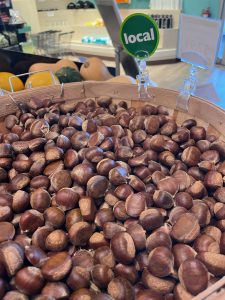The American chestnut tree, (Genus: Castanea dentata, Species: C. sativa, Family: Fagaceae) is a large monoecious deciduous tree. This big, beautiful tree provides green shade in the summer, a stunning display of fall foliage, and a spinney cupule (bur) that holds and protects the chestnut during its growth and maturation. As the chestnut leaves fall, so does the bur. When the bur splits, it releases the chestnut.
The American chestnut was once a VERY important tree for food and forage as well as used as an impressive wood. Unfortunately, this important tree was largely decimated by chestnut blight, a fungal disease (Cryphonectria parasitica). It is estimated that between 3 and 4 billion American chestnut trees were destroyed in the first half of the 20th century.
Scientific research discovered that the Chinese chestnut tree (Castanea mollissima) is recognized as being highly blight resistant (but not immune). Many places in the United States have replanted the American chestnut tree with the Chinese chestnut and its cultivars. In fact, in this general region, there are several chestnut orchards.

The chestnut is classified as a nut… a dry drupe. However, the chestnut differs from most nuts, as it is low in lipid (fat), high in carbohydrates, and rich in vitamins and minerals. The mature chestnut (nut pulp) is more than 50 percent water; special care must be taken to extend its storage so it does not spoil. In fact, chestnuts are highly perishable and should be treated more as a fruit than a dry nut because of its high water content.
Locally, fresh chestnuts are generally only available in the fall. A good chestnut is large, firm to the touch, and feels dense. The USDA does not have any standards for grades of chestnuts, although sometimes size standards are based on the number of nuts per pound.
According to the American Chestnut Foundation®, if nuts are to be stored for eating, store fresh chestnuts in a paper grocery bag for up to two months. Leaving fresh chestnuts at room temperature for a few days helps their starches convert to sugar. For longer storage, put chestnuts in the freezer and use immediately after thawing or they will become mushy.
Chestnuts can be eaten in a variety of forms:
• Fresh – dry roasted (no oil in the pan) or boiled
• Frozen
• Dried
• Canned
• Pureed
• Ground into gluten-free flour
Cooking methods for chestnuts vary widely. Customarily, chestnuts are dry-roasted in the oven, over hot coals, on top of the stove in a skillet, or in the microwave. With the introduction of the Air Fryer and the Instant Pot, the internet is teeming with chestnut recipes for these appliances, too. Whatever method you choose, whether the chestnut is pureed, added to soups, stews, stuffings, and vegetable dishes or even turned into a decadent dessert, the chestnut is a tasty treat.
Traditional Dry Roasting Method for Chestnuts
1. Heat a skillet on top of the stove or preheat the oven to 425° F
2. Rinse the chestnuts in cold water. (Rinsing removes any bird droppings, etc….)
3. Using a sharp knife, score the round side of each chestnut nut with an “X” (the chestnut is FULL of moisture, the “X” keeps the chestnut from exploding due to expansion and makes it easier to peel).
4. Using a roasting pan or skillet, place the chestnuts in the oven, over an open fire, or on top of the stove, flat side down.
5. Dry roast, stirring every five minutes until the shells begin to split open (at this point, the shells are brittle and have curled back some at the X).
6. Remove from the heat when the insides feel soft (this will depend on the nut but usually about 15 – 20 minutes).
7. Wrap in a dish cloth and massage a bit.
8. When cool enough to handle, peel the shells off the chestnuts.
9. Enjoy warm or cold or added to your favorite recipe.
The internet contains a wealth of chestnut recipes. Pick one out to try.
Bon Appetit!
- It’s Chestnut Season! - December 16, 2022
- Persimmons: Food of the Gods - November 23, 2022
- Have You Ever Thought About Entering Baked Goods in the North Florida Fair? - October 28, 2022
